How to detect plagiocephaly?
This page will help you detect and assess if your baby has plagiocephaly , brachycephaly or scaphocephaly . In case of doubt, it is always advisable to contact your pediatrician, or our team directly.
You may have noticed at bath time as you passed a mirror, or perhaps someone commented on the shape of your baby’s head. Unfortunately, skull deformities are not uncommon nowadays. According to According to Aliyah Mawji, RN, of the Canadian Pediatric Society, in her article The incidence of positional plagiocephaly: a cohort study ,“The incidence of plagiocephaly in infants aged 7 to 12 weeks has been estimated at 46. 6%. Of the total number of infants with plagiocephaly, 63.2 % were affected on the right side and 78.3 % had a mild form. “
Undoubtedly, an abnormal head shape raises many questions, the first of which is a common one, “Am I really seeing what I think I am seeing?”
A diagnosis of plagiocephaly looks very different from one baby to another, no two cases are the same. It can guide you ( by way of guidance ) through evaluating your baby’s head shape from five different points of view , helping you better understand your child’s condition and choose the right treatment for him or her.
The information provided in this page is indicative and is not intended to replace an evaluation by a medical professional .We recommend you visiting your paediatrician for a confirmed diagnosis. We invite you to speak directly with one of our expert doctors by scheduling an evaluation.
I. From above
To start, have someone hold your baby in your lap while you stand and look at the top of your baby’s head. From this point of view, what is the general shape of your baby’s head? Normally, the head is about 1/3 as long as it is wide. In flat head syndrome, the head may appear flat on one side, wide at the back, or long and narrow.
Below we have provided examples of abnormal head shapes you may see. Keep in mind that you may not see these forms exactly: variations ranging from mild to moderate to severe and even combinations of these forms may occur.
To start, have someone hold your baby in your lap while you stand and look at the top of your baby’s head. From this point of view, what is the general shape of your baby’s head? Normally, the head is about 1/3 as long as it is wide. In flat head syndrome, the head may appear flat on one side, wide at the back, or long and narrow.
Below we have provided examples of abnormal head shapes you may see. Keep in mind that you may not see these forms exactly: variations ranging from mild to moderate to severe and even combinations of these forms may occur.
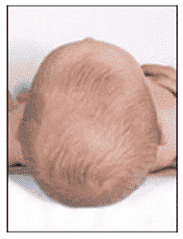
Normal head shape
- The head is 1/3 longer than it is wide.
- ears are aligned
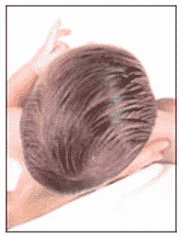
Head shape with plagiocephaly
- The head is flattened either on the right or left rear side.
- ears are not aligned
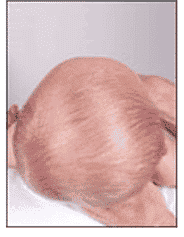
Head shape with brachycephaly
- The head is wider than long
- The back of the head is flatter than curved
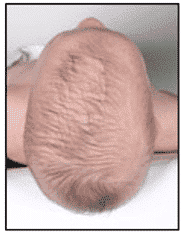
Head shape with scaphocephaly
- The head is long and narrow
II. Profile
Then, with your baby still sitting on someone else’s lap or looking in a mirror, look at the shape of your baby’s head from both sides. Normally, the back of the head is curved and both sides of the head meet. Look for flattened or tilted areas of the head and check to see if one ear is closer to the shoulder than the other .
Then, with your baby still sitting on someone else’s lap or looking in a mirror, look at the shape of your baby’s head from both sides. Normally, the back of the head is curved and both sides of the head meet. Look for flattened or tilted areas of the head and check to see if one ear is closer to the shoulder than the other .
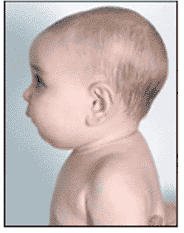
Normal head shape
- The back is curved
- The two backs of the head are the same
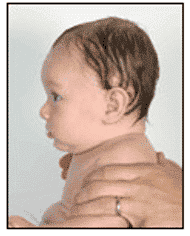
Head shape with plagiocephaly
- One ear is closer to the shoulder than the other
- One part of the head is curvier than the other
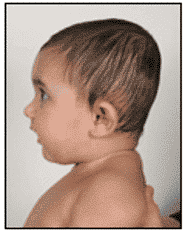
Head shape with brachycephaly
- The head is shorter in front than behind; that is high in the back
- Flat head rear
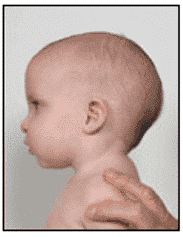
Head shape with scaphocephaly
- The head is longer in distance at the front than at the back.
III. Ear Alignment
By looking at the alignment of your baby’s ears from above, you can determine the severity of the condition.
While holding your baby on your own lap this time, gently place an index finger in each of their ears. How are your fingers aligned? A more noticeable misalignment indicates a more severe condition.
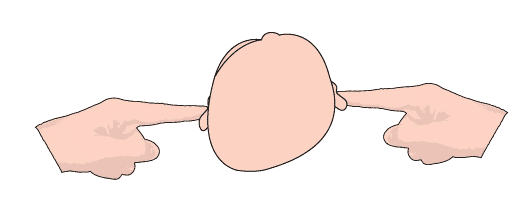
It is especially important to note what you see here. While plagiocephaly is a highly treatable condition, research has shown that the best results are achieved when treatment begins early. Because cranial cap therapy is effective for a short period of time and severe cases of plagiocephaly are more complex to correct, it is crucial that infants with advanced forms of the condition begin treatment as soon as possible.
IV. Front View
Next, we will look at the symmetry of your baby’s face. Since you see your baby’s face every day, the best way to spot the differences between the right and left sides is to hold your baby in front of a mirror and look at his or her reflection. How level are the eyes and the top of the head? Is one cheek fuller than the other? How big is the head in relation to the face ? Examples of what to look for are provided below.
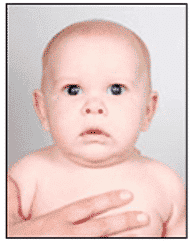
Normal head shape
- The eyes are the same size and are aligned
- Cheeks are the same size
- The top of the head is flat
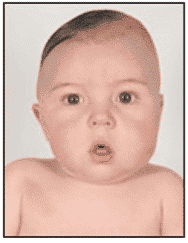
Head shape with plagiocephaly
- One eye is smaller than the other
- One cheek is smaller than the other
- The top of the head is not flat
- Head height is not level
- The mouth is not symmetrical
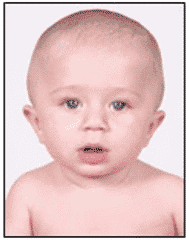
Head shape with brachycephaly
- The face looks small compared to the head
- the head is wide
- The widest part is just above the ears
- The tops of the ears stick out
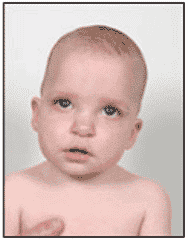
Head shape with scaphocephaly
- The head is long and narrow
- The forehead is elongated
V. From below
Lastly, we will look at your baby’s head from below. To do this, lay your baby on his back. With your baby’s face looking directly up at the ceiling, assess the angle and shape of the forehead and the general shape of the head. Is the forehead level or sloped? Round or square? Does the head appear wide or narrow? Use the examples below for context.
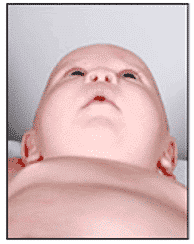
Normal head shape
- Eyes and ears are level
- The forehead is arched and level
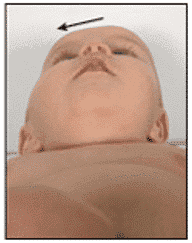
Head shape with plagiocephaly
- The forehead is tilted
- The face is tilted and appears deviated
- The eyes and ears are not aligned
- One cheek appears larger than the other
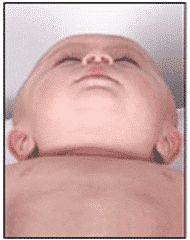
Head shape with brachycephaly
- the head is wide
- The widest part of the head is just above the ears
- The forehead is flat, not rounded
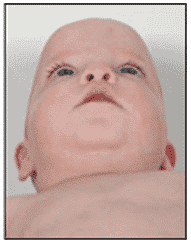
Head shape with scaphocephaly
- the head is narrow
- the forehead is square
The information provided in this page is indicative and is not intended to replace an evaluation by a medical professional .We recommend you visiting your paediatrician for a confirmed diagnosis.
Visit our FAQ page to find out more.
If you have questions on how to detect plagiocephaly and other skull deformities, do not hesitate to contact us. Our team with more than 35 years of experience, with over 4200 successfully treated patients.

